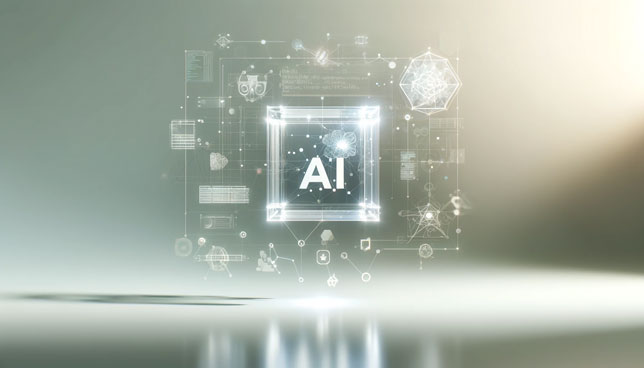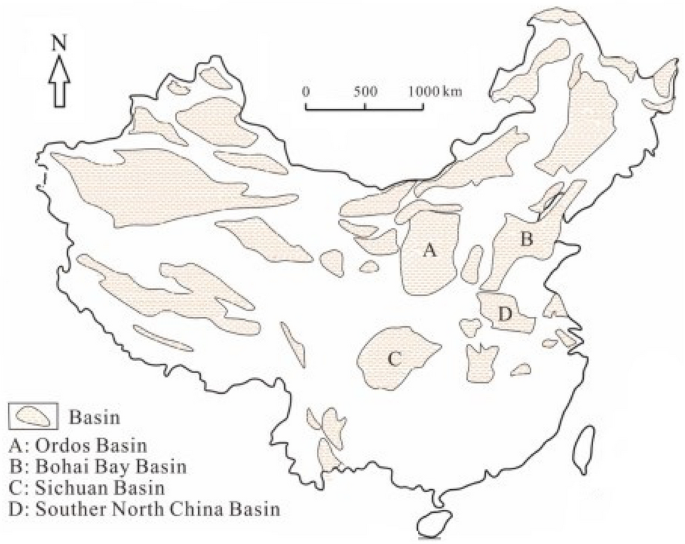The analysis of educational informatization management learning model under the internet of things and artificial intelligence

Fog computing-based hierarchical Q-learning (Q) algorithm enhanced learning model
This study comprehensively integrates various AI technologies to optimize student management in educational information management systems. Initially, deep learning and machine learning algorithms are employed to process and analyze extensive student data, including learning time, progress, homework completion, and exam scores. Based on this data, the system generates personalized learning reports and offers tailored learning recommendations and resource suggestions for each student. Specifically, the experiment utilizes Q-learning algorithm to create a hierarchical Q-learning model, enabling intelligent selection of optimal strategies under different states to achieve personalized teaching support. Q-learning, a reinforcement learning algorithm, continuously updates the Q-function to enhance decision-making processes. The reward and decision matrices in the model provide foundational data, while the Q-function learns from these data updates, ultimately constructing the core framework. This framework enables the student management system to intelligently select the best strategies based on student status and needs, thereby providing more personalized, intelligent, and efficient teaching support. Furthermore, the experiment introduces NLP technology to analyze students’ textual data, including learning notes, discussion contributions, and online interaction records. Through sentiment analysis and topic modeling, the system better understands students’ learning needs and emotional states, offering personalized academic support. For instance, when the system detects low student morale, it promptly delivers encouraging learning content or provides additional assistance. In terms of resource recommendations, collaborative filtering algorithms analyze students’ academic histories and interests to recommend suitable textbooks, courses, and learning resources. Collaborative filtering algorithms leverage historical data from similar students to enhance recommendation accuracy and relevance significantly. Moreover, supervised learning algorithms are used to analyze students’ academic data and behavioral patterns to predict their future learning needs and performance. This process not only helps teachers anticipate potential issues students may face but also provides targeted coaching recommendations. To enhance the system’s real-time responsiveness, fog computing technology is integrated, pushing computing and data storage closer to students’ locations. This reduces latency, improves system response speed, and allows for faster and more systematic capture and analysis of student needs and behaviors. Through these methods, educational management systems can swiftly identify student requirements, including learning habits and knowledge mastery, thereby providing more precise support. This study integrates Q-learning algorithm, NLP technology, collaborative filtering algorithm, and supervised learning algorithm, combined with fog computing technology, to achieve intelligent identification of student needs, rational allocation of learning resources, and dynamic optimization of the educational process. The application of these AI technologies not only enhances the intelligence level of student management systems but also significantly improves student learning experiences and outcomes, thereby providing robust support for personalized education development.
The fog computing-based hierarchical Q algorithm enhanced learning model is an intelligent strategy employed for resource scheduling35,36,37. The Q algorithm serves as a principal algorithm for reinforcement learning, offering intelligent systems the ability to make optimal choices based on action sequences within a Markov environment. Markov decision processes are employed to address optimization problems within Markov chains38,39. The specific process is as follows:
Step 1: Construct the reward matrix for the Q algorithm;
The structure of the reward matrix E is represented by Eq. (1):
$$E=\left[\beginarrayccc\beginarrayce_11\\ e_21\\ \beginarrayc\vdots \\ e_m1\endarray\endarray& \beginarrayce_12\\ e_22\\ \beginarrayc\vdots \\ e_m2\endarray\endarray& \beginarraycc\beginarrayc\cdots \\ \cdots \\ \beginarrayc\ddots \\ \cdots \endarray\endarray& \beginarrayce_1n\\ e_2n\\ \beginarrayc\vdots \\ e_mn\endarray\endarray\endarray\endarray\right]$$
(1)
\(e_ij\) represents the reward value of the jth action under the ith state, and it can be assigned as 0, positive, or negative values. The form of the decision matrix D is expressed by Eq. (2):
$$D = \left[ {\beginarray*20c \beginarray*20c d_11 \\ d_21 \\ \beginarray*20c \vdots \\ d_m1 \\ \endarray \\ \endarray & \beginarray*20c d_12 \\ d_22 \\ \beginarray*20c \vdots \\ d_m2 \\ \endarray \\ \endarray & {\beginarray*20c \beginarray*20c \cdots \\ \cdots \\ \beginarray*20c \ddots \\ \cdots \\ \endarray \\ \endarray & \beginarray*20c d_1n \\ d_2n \\ \beginarray*20c \vdots \\ d_mn \\ \endarray \\ \endarray \\ \endarray } \\ \endarray } \right]$$
(2)
In Eq. (2), \(d_ij\) signifies the decision value of the jth action under the ith state. These two matrices form the basis of the Q learning algorithm to evaluate and select actions during the learning process. The purpose is to guide the algorithm to choose the optimal strategy in the learning process so that the system can make intelligent decisions.
Step 2: Define the transition function;
In this study, the utilized transition function is the Q function, which facilitates state transitions through the Bellman equation. The form of the Q function reads:
$$Q\left[ s,a \right] = Q\left[ s,a \right] + \alpha \left( e + \gamma \max Q\left[ s^\prime,a^\prime \right] – Q\left[ s,a \right] \right)$$
(3)
In Eq. (3), s represents the current state. sʹ indicates the next state. a signifies the current action. aʹ demonstrates the subsequent action, e refers to the reward value of executing the current action in the current state, α denotes the learning rate, and \(\upgamma\) represents the discount factor for future influence. This updating process is the core of the Q learning algorithm, and through learning and optimization, the algorithm can gradually converge and find the optimal strategy.
Step 3: Establish the Q algorithm;
This algorithm comprises the training phase and the utilization phase. The training phase primarily involves iterative learning to facilitate rapid algorithm convergence40,41,42. The utilization phase necessitates the computation of the results for the decision matrix D. The E matrix is updated, and convergence is achieved. The algorithmic process is outlined in Table 1:
In the training stage, the system learns iteratively through the Q learning algorithm according to the reward and decision matrix until it converges. In the application stage, the system uses the learned Q value to determine the current optimal action and realize the intelligent decision.
Step 4: The reinforcement learning model establishment of the hierarchical structure Q algorithm;
Figure 1 presents the structure of the hierarchical structure Q algorithm enhanced learning model.
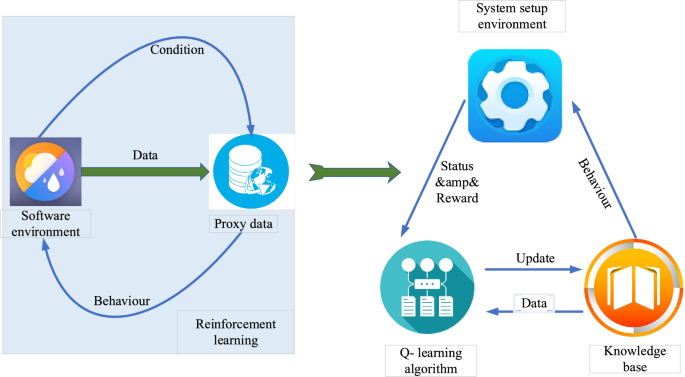
Structure of hierarchical Q algorithm enhanced learning model.
In Fig. 1, the comprehensive structure of the hierarchical Q algorithm enhanced learning model consists of two main components: the agent and the system environment. The agent, which integrates AI technology, serves as the model’s core and interacts with the system environment, facilitated by integrating IoT technology43. This model, which is at the heart of the study, combines the Q-learning algorithm with IoT and AI technologies to enable intelligent, personalized, and efficient student management and teaching support.
Generally, the reward and decision matrices provide the basic data for Q-learning algorithms. The Q function is updated by learning these data, and the Q algorithm uses the Q function for training and decision-making. Finally, the core framework of the hierarchical Q learning algorithm reinforcement learning model is constructed. This framework enables the student management system to intelligently select the best strategy according to the state and needs of students, and provide personalized, intelligent, and efficient teaching support.
The proposed fog computing algorithm is closely related to educational information management goals when applied to this management system.
-
1)
Intelligent identification of student needs Fog computing algorithms push computing and data storage closer to students through fog nodes, achieving lower latency and faster response times. In this way, students’ needs and behaviors can be more quickly, systematically captured, and analyzed. By intelligently identifying the needs of students, the education management system can better understand students’ learning status, including learning habits, knowledge mastery, and so on.
-
2)
Allocation of learning resources The fog computing algorithm can intelligently allocate learning resources according to students’ needs and the system’s actual situation. This includes course materials, online tutorials, assignments, and more. Through reasonable resource allocation, students can get personalized learning experiences, and the system can better meet the learning needs of different students.
-
3)
Dynamic optimization of the education process Fog computing algorithm enables the system to monitor students’ learning progress and feedback information in real-time. Based on this information, the system can dynamically adjust the educational process, such as adjusting the learning content, providing personalized tutoring suggestions, adjusting the learning difficulty, etc. This dynamic optimization ensures that each student learns independently and improves learning outcomes.
-
4)
Improve learning outcomes Through intelligent identification of student needs, reasonable allocation of learning resources, and dynamic optimization of the education process, the education management system can better guide students to learn, improve learning enthusiasm, and increase learning time, thus promoting learning outcomes. Students in such a system are more likely to get good grades, more likely to get recognition for their learning progress, and thus improve learning motivation.
In summary, the proposed fog computing algorithm is correlated with educational information management goals by realizing intelligent identification of student needs, allocation of learning resources, and dynamic optimization of the educational process. It offers strong technical support for the education management system so that schools and educational institutions can better meet the learning needs of students, enhance education quality, and promote the realization of personalized education.
Advanced student management system: integrating sensor-based IoT and machine learning AI technologies
Integrating IoT and AI technologies, the student management system is a modern IT-based educational management solution. It aims to intelligently monitor, analyze, and provide personalized guidance for student learning and behavior by merging IoT and AI technologies44,45,46. The specific design process is as follows:
Step 1: Designing student management system features and execution sequence.
Figure 2 illustrates the functional and chronological representation of the student management system.
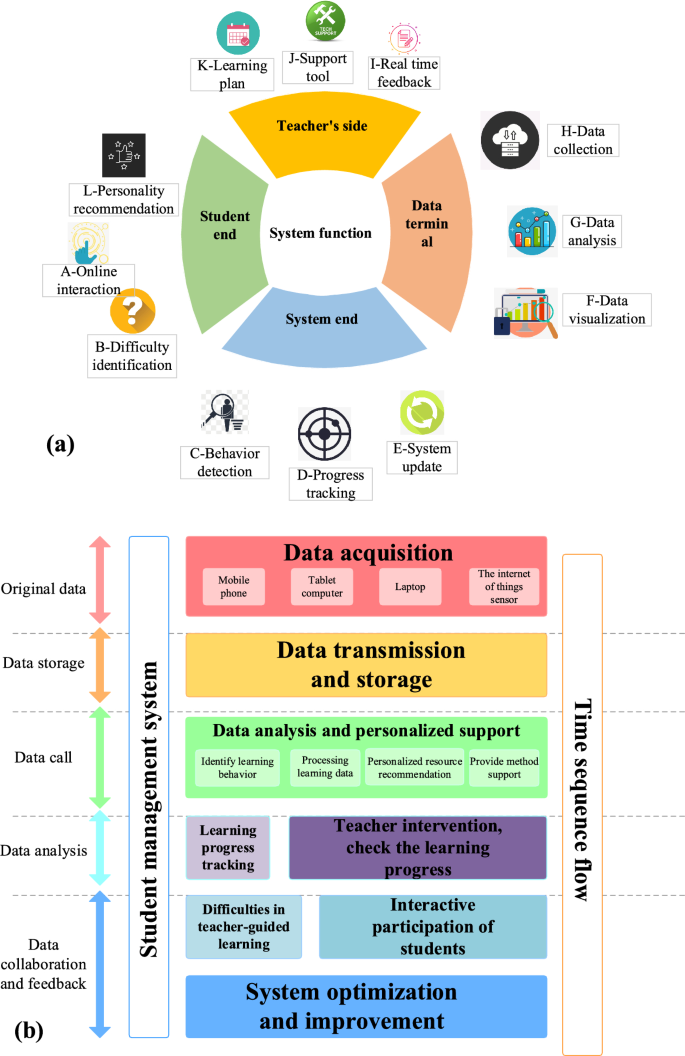
Functional and Chronological Representation of Student Management System ((a) depicts the functional diagram; (b) illustrates the management chronology).
In Fig. 2, the student management system integrating IoT and AI technologies encompasses various functionalities. It covers student learning behavior detection, data collection and analysis, personalized learning recommendations, and provision of more intelligent, personalized, and efficient student management and instructional support47,48. This study employs a variety of sensors and IoT devices to monitor and collect students’ learning behavioral data. These devices include: motion sensors for tracking students’ physical activities and movements to determine their engagement in learning; environmental sensors to monitor classroom or learning environment conditions, ensuring comfort; RFID tags and readers to record students’ attendance and location changes; smart wearable devices such as smartwatches and wristbands to monitor students’ heart rates and emotional states; cameras and microphones for analyzing students’ facial expressions and speech to assess emotions and participation. These sensors and IoT devices work together to provide real-time data on students’ learning processes, facilitating intelligent decision-making and feedback systems. Despite the significant advantages of sensors and IoT devices in data collection, they also present some limitations. Certain sensors may fail to provide high-precision data due to environmental interference or technical constraints of the devices themselves. The use of cameras and microphones may raise concerns among students regarding privacy breaches, necessitating strict data protection measures. IoT devices may become ineffective due to hardware failures or network issues, leading to data loss or incompleteness. High-quality sensors and IoT devices incur high costs, potentially adding financial pressure to schools or institutions. The student management chronology comprises eight phases: data collection and analysis. Each phase offers improved support and assistance for students and teachers, thus enhancing the education quality and students’ learning outcomes49,50,51.
Specifically, the system can use IoT sensor technology to monitor students’ learning behavior in real-time, encompassing study time, subject preferences, etc. IoT sensors are employed to collect student academic data, and AI technology is used for data analysis to gain insights into student learning patterns and progress.
In terms of personalized learning recommendations, based on AI algorithms, the system can analyze students’ academic performance and provide personalized learning recommendations and resource recommendations for each student. The recommendation algorithm based on collaborative filtering is utilized to recommend textbooks, courses, and learning resources suitable for each student’s learning needs based on their academic history and interests. Meanwhile, the supervised learning algorithm is adopted to analyze students’ academic data and behavior patterns and predict students’ future learning needs and performance. For students’ text data, the NLP algorithm is used for sentiment analysis, topic modeling, etc., to better understand students’ academic needs and emotional states, and give personalized academic support. Regarding teaching support, the reinforcement learning algorithm is adopted to provide intelligent decision-making assistance for teachers, optimize teaching strategies and resource allocation, and improve teaching effects.
In short, combined with IoT and AI, the system can provide intelligent decision-making assistance for teachers, including suggestions for adjusting teaching content and analysis reports on student behavior.
Step 2: Designing the system database.
The student management system database should encompass several tables, involving user information, class information, teacher information, student performance, course details, course schedules, and classroom information52,53,54,55.
Step 3: Establishing the student management system environment.
This study constructs the system environment based on the functionalities and chronological sequence of the student management system. The development environment is exhibited in Table 256,57,58,59.
Table 2 showcases that the student management system designed in this study is based on the B/S architecture. The system is divided into the presentation, transaction, and data logic layers, aligned with the environment and platform specified in the preceding table to facilitate system development.
Step 4: Constructing the architecture of the student management system60,61,62.
The architecture of the student management system is illustrated in Fig. 3.
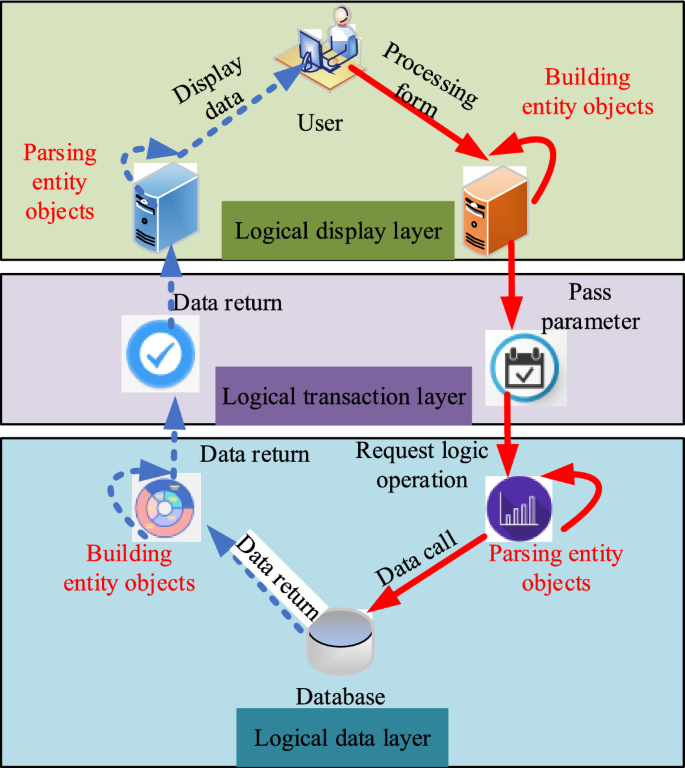
Framework of student management system.
Figure 3 displays the architecture of the student management system, which is divided into three main components: presentation logic layer, transaction logic layer, and data logic layer63,64,65,66,67.
The presentation logical layer is responsible for handling various requests from users. When users interact with the system, this layer converts their requests into machine code so that the system can understand and process them. The main task of this layer is to ensure user interface friendliness and ease of use while translating user actions into instructions that the system can understand for further processing.
The transaction logic layer receives instructions and requests from the presentation logic layer. At this layer, the system performs logical evaluation and processing to ensure the legality and security of user requests. The transaction logic layer is responsible for coordinating the execution sequence of various tasks and ensuring the system functions as expected. If a user request involves multiple steps, this layer coordinates the sequence of these steps to ensure the integrity and accuracy of the entire operation.
The data logic layer processes and storages data. In this layer, the system passes the data processed by the presentation logic layer and the transaction logic layer to the corresponding database for storage. The data logic layer ensures data consistency, integrity, and security. It is responsible for storing data in a database so the system can retrieve and use it quickly and accurately when needed. This layer’s design directly affects the system’s performance and stability.
Through this layered architecture, the student management system realizes the efficient processing of user requests and stable data transmission and storage. The clear division among the presentation logic layer, the transaction logic layer, and the data logic layer makes the system easier to maintain and upgrade, while also improving the reliability and performance of the system. The design of this structure ensures that the student management system can maintain high efficiency, stability, and reliability when dealing with many user requests and data. To validate each student’s performance, this study achieves this goal through multi-layered, multi-dimensional data analysis, and a real-time monitoring system. First, IoT devices and sensor networks are utilized to collect various types of student data during the learning process. These devices include motion sensors, environmental sensors, RFID tags, smart wearable devices, cameras, and microphones, which comprehensively monitor students’ physical activities, learning environments, attendance, emotional states, and facial expressions. Through these data collection methods, the system obtains detailed behavior records of students at different times and periods. Subsequently, the system inputs these data into AI algorithms for deep analysis. The experiment employs various AI technologies, including Q-learning algorithms, NLP techniques, collaborative filtering algorithms, and supervised learning algorithms. These technologies work together to comprehensively assess students’ learning habits, knowledge mastery, emotional states, and interaction situations, thereby generating personalized learning reports. Specifically, the Q-learning algorithm continuously updates the Q-function to select optimal learning strategies for students. NLP techniques perform sentiment analysis and topic modeling on students’ textual data to understand their psychological states and academic needs. Collaborative filtering algorithms recommend suitable learning resources based on students’ historical data and interests. Supervised learning algorithms predict students’ future learning needs and performance by analyzing their academic data and behavior patterns. To ensure comprehensive and accurate evaluation, the system also generates detailed academic reports regularly. These reports not only include students’ learning progress, grade changes, and completion of assignments but also provide a comprehensive assessment of students’ participation in classroom discussions, online interactions, and extracurricular learning. Teachers and administrators can use these reports to promptly understand each student’s learning status and potential issues, thereby implementing targeted intervention measures to help students optimize their learning strategies and enhance learning outcomes. Moreover, the system features real-time feedback capabilities. When learning difficulties or emotional fluctuations are detected in students, the system can immediately alert teachers, prompting them to provide timely guidance and support. Additionally, the system automatically adjusts learning content and difficulty levels, providing students with different levels of learning materials based on their actual situations, ensuring that each student can steadily improve at their own pace. Through these methods, the student management system proposed in this study not only comprehensively and accurately verifies students’ optimal performance but also provides personalized and intelligent learning support. This not only contributes to improving students’ academic achievements but also enhances their motivation and confidence in learning, ultimately achieving overall improvement in educational quality and comprehensive promotion of personalized education.
link


